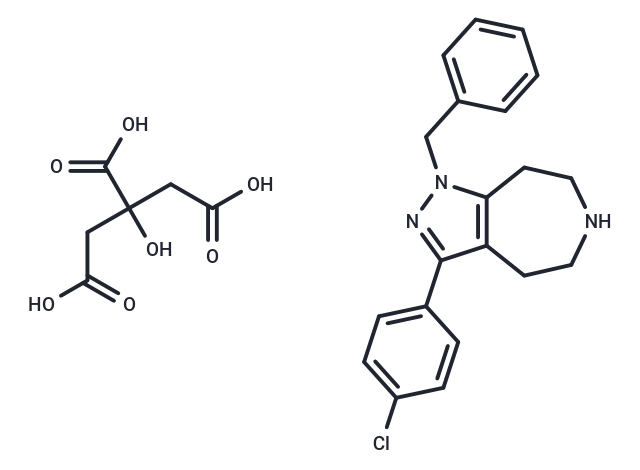Shopping Cart
- Remove All
 Your shopping cart is currently empty
Your shopping cart is currently empty


| Pack Size | Price | Availability | Quantity |
|---|---|---|---|
| 2 mg | $30 | In Stock | |
| 5 mg | $46 | In Stock | |
| 10 mg | $83 | In Stock | |
| 25 mg | $173 | In Stock | |
| 50 mg | $273 | In Stock | |
| 100 mg | $403 | In Stock | |
| 200 mg | $573 | In Stock | |
| 1 mL x 10 mM (in DMSO) | $50 | In Stock |
| Description | JNJ-18038683 is a 5-Hydroxytryptamine Type 7 (5-HT7) receptor antagonist with pKis of 8.19 and 8.20 for rat and human 5-HT7 in HEK293 cells, respectively. |
| Targets&IC50 | 5-HT7 receptor (human):8.2(pKi, in HEK293 cells ), 5-HT7 receptor (rat):8.19(pKi, in HEK293 cells ) |
| In vitro | JNJ-18038683 produces a concentration-dependent decrease of 5-HT (100 nM)-stimulated adenylyl cyclase. The pKB values determined for JNJ-18038683 are in good agreement with the corresponding Ki values determined from [3H]5-CT binding studies.JNJ-18038683 displaced, with high affinity, specific [3H]5-CT binding sites from rat and human 5-HT7 receptor express in HEK293 cells (pKi=8.19±0.02 and 8.20±0.01, respectively). Similar values are obtained on the native 5-HT7 in membranes from rat thalamus (pKi=8.50±0.20). Hill slope values are close to unity, suggesting one-site competitive binding. Antagonist potency of JNJ-18038683 is determined by the measurement of adenylate cyclase activity in HEK293 cells expressing the human or rat 5-HT7 receptor. 5-HT stimulates adenylyl cyclase activity in rat and human 5-HT7/HEK293 cells with a pEC50 of 8.09 and 8.12, respectively. |
| In vivo | JNJ-18038683 dose-dependently reduces REM sleep, particularly within the first 4 hours post-administration, with a significant decrease observed from a dosage of 1 mg/kg (P<0.05). Furthermore, it extends REM sleep latency, showing a significant prolongation at the highest dose tested (10 mg/kg; P<0.05), indicating that these effects are specific to the REM sleep state. An additional study evaluated the impact of administering JNJ-18038683 daily for 7 days (1 mg/kg s.c. per day) on EEG sleep patterns in rats, focusing on REM sleep both during treatment and after its cessation. Initial treatment significantly reduced REM sleep duration in the first 8 hours and increased REM latency, which remained elevated throughout the 7-day treatment but returned to normal after treatment stopped. While the reduction in REM sleep persisted during the treatment period, a rebound increase in REM sleep occurred upon treatment discontinuation. Neither the latency nor the total time of NREM sleep was impacted over the treatment course. |
| Molecular Weight | 529.97 |
| Formula | C26H28ClN3O7 |
| Cas No. | 851376-05-1 |
| Storage | Powder: -20°C for 3 years | In solvent: -80°C for 1 year | Shipping with blue ice. | |||||||||||||||||||||||||||||||||||
| Solubility Information | DMSO: 200 mg/mL (358.51 mM), Sonication is recommended. | |||||||||||||||||||||||||||||||||||
Solution Preparation Table | ||||||||||||||||||||||||||||||||||||
DMSO
| ||||||||||||||||||||||||||||||||||||

Copyright © 2015-2024 TargetMol Chemicals Inc. All Rights Reserved.